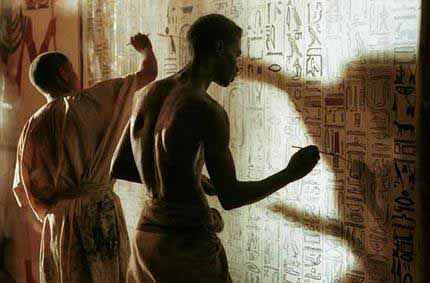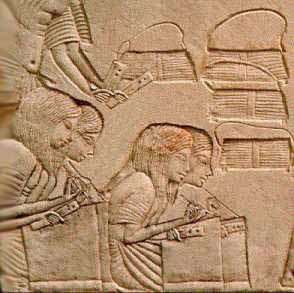

Education in Egypt was largely vocational an apprenticeship served within the family trade or craft usually under the boy's father. We know something of the system from the craftsman's community of Dier el-Medina. Boys were taught skills by their father in the hope of at least on son winning a place in the official corps of tomb-builders. Those youths who were most likely to be accepted were designated children of the tomb. They were attached to one of the gangs to do odd jobs and run, but no doubt primarily to watch and learn until such time as a place became available for them. Offspring who failed to achieve one of these coveted, lucrative positions had to leave the village, either to set up as craftsmen elsewhere or to seek a different type of job.
A more formal, academic education was reserved for those who trained to be scribes. Elementary schooling for these privileged children, mostly boys, began at about five years of age and consisted of repeated recitation of lessons as well as the copying of standard texts. The basic proper may have been a book called Kemty, which means' completion;. The form and style of the surviving copies of this work indicate that it was composed in the Middle Kingdom, although it was still used a thousand years later. The reason for its continued popularity as a teaching book was the simplicity of its language and the fact that the text was set out in vertical columns rather than horizontal lines, so that the signs were easier for young children to copy. The contents of the Kemty consisted of model letters phrases and expressions useful to scribes assorted wisdom texts giving advice to would be scholars.
Having mastered the basics, the student could progress to more advanced text. The majority of these were classics of Egyptian literature; in particular the wisdom texts full of pronouncements on morals and behavior for young men who hoped to achieve some position in life. This genre and a long history in Egypt. The sage Imhotep wrote such a work, now lost, in the Third Dynasty and the latest surviving example, the instructions of Onkhsheshongy, is probably Ptolemaic. These wisdom texts are couched in the form of a discourse from a learned master, father or teacher to his pupil, A fair amount of the advice they contained inspired the scholar to diligence. In the words of the scribe Amenemope, pass on day in idleness or you will be beaten. The ear of a boy is on his back. He listens when he is beaten.
The final years of scribal training were probably vocational, wither working with a master or attending on of the specialized schools run by the major employers of scribes such as the royal palace, government departments, the army or temples, In these schools the trainee would receive knowledge applicable to jobs future employment: mathematics anqad surviving for tax assessors, ritual practices or medicine for future priests, and so on.
At the other end of the social scale and at the lowest level of an Egyptian household were the servants and salves who performed all the mundane duties, but who received little reward. To a certain extent the whole of Egypt was in a state of servitude, for the structure of society was hierarchical and everyone owned duty to someone at a higher level, and ultimately to Pharaoh, who was the embodiment of the State, Nevertheless. at the bottom of the heap it becomes difficult to differentiate be teen the oppressed peasant laborer and those officially designated as slaves.
Unskilled peasant farmer were attached o an estate belonging to Pharaoh, the government, a temple or a rich landowner. Their pay was barely more than subsistence or, of they cultivated land, a large percentage of the harvest was taken in rent and taxes, and this group of people was the main target of Corvee duty. Forced labor raised specific tasks such as the upkeep of irrigation system construction of public buildings and cultivation of land, for this work no pay at all was received, only keep. All but he official classes were obliged to undertaker the Corvee, but anyone who cloud afford to do so would pay for exemption this ensuring that the weight of the burden fell on the poor. If, however, the Corvee workers attempted to run away from their labour, they were classed as fugitives and, if caught sentenced to permanent servitude spending the time between jobs on prison, their children then seem to have inherited the parents' status as State servants.

The Prince's School was the most respected of all of the schools and gave the very best Ancient Egyptian education. There the sons of the Pharaoh, members of the royal family, nobles and high officials, would receive education. There was also a scheme which allowed recommendations when young boys who showed great promise were also allowed in the Prince's school. The Vizier had overall control of the Prince's school and therefore the education of the next Pharaoh, nobles and court officials. Curriculum included:
Music and Ceremonial Dance
Reading and Writing and Hieroglyphs
Mathematics and Geometry
History, Geography and Cartography
Science, Astronomy, Astrology, and Medicine
Deir el-Medina is an ancient Egyptian village which was home to the artisans who worked on the tombs in the Valley of the Kings during the 18th to 20th dynasties of the New Kingdom period (ca. 1550-1080 BC). The settlement's ancient name was "Set Maat" (translated as "The Place of Truth"), and the workmen who lived there were called "Servants in the Place of Truth". During the Christian era the temple of Hathor was converted into a Church from which the Arabic name Deir el-Medina ("the monastery of the town") is derived.
At the time when the world's press was concentrating on Howard Carter's discovery of the Tomb of Tutankhamun in 1922 a team led by Bernard Bruyere began to excavate the site. This work has resulted in one of the most thoroughly documented accounts of community life in the ancient world that spans almost four hundred years. There is no comparable site in which the organization, social interactions, working and living conditions of a community can be studied in such detail.
The site is located on the west bank of the Nile, across the river from modern-day Luxor. The village is laid out in a small natural amphitheatre, within easy walking distance of the Valley of the Kings to the north, funerary temples to the east and south-east, with the Valley of the Queens to the west. The village may have been built apart from the wider population in order to preserve secrecy in view of sensitive nature of the work carried out in the tombs.
Surviving texts record the events of daily life rather than major historical incidents. Personal letters reveal much about the social relations and family life of the villagers. The ancient economy is documented by records of sales transactions that yield information on prices and exchange. Records of prayers and charms illustrate ordinary popular conceptions of the divine, whilst researchers into ancient law and practice find a rich source of information recorded in the texts from the village. Many examples of the most famous works of Ancient Egyptian literature have also been found. Thousands of papyri and ostraca still await publication.